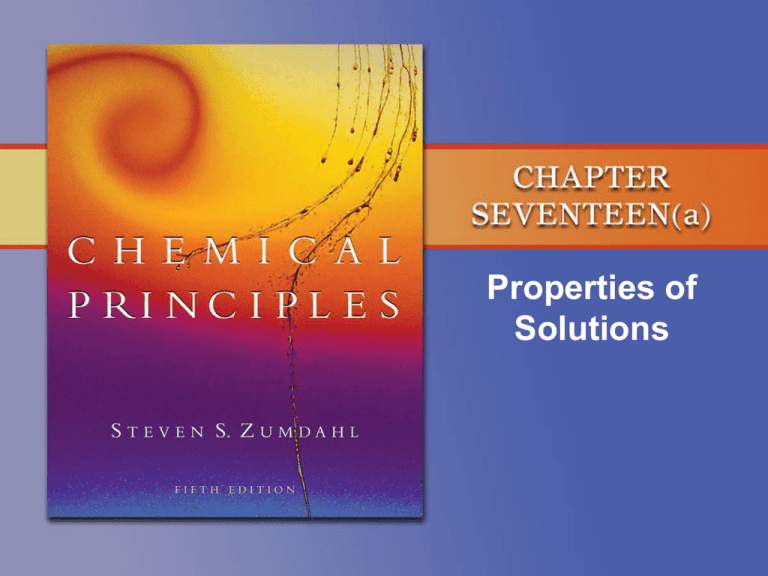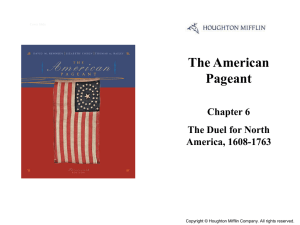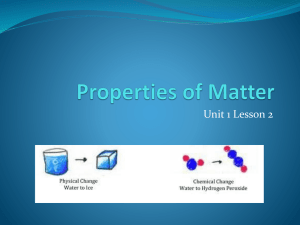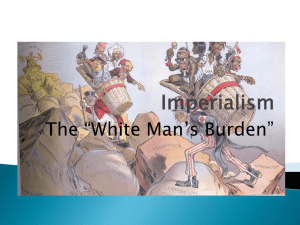
Properties of
Solutions
The left beaker contains copper sulfate solution.
In the right beaker, ammonia is being added to create a
precipitate of copper(II) hydroxide.
Copyright © Houghton Mifflin Company. All rights reserved.
17a–2
Copyright © Houghton Mifflin Company. All rights reserved.
17a–3
Figure 17.1: The formation of a liquid
solution can be divided into three steps
Copyright © Houghton Mifflin Company. All rights reserved.
17a–4
Figure 17.2: (a) Enthalpy of solution Hsoln has a negative sign (the process is
exothermic) if Step 3 releases more energy than is required by Steps 1 and 2.
(b) Hsoln has a positive sign (the process is endothermic) if Stpes 1 and 2 require
more energy than is released in Step 3.
Copyright © Houghton Mifflin Company. All rights reserved.
17a–5
French Navy ship L'Ailette equipped with
vacuum pumps approaches an oil slick.
Source: AP/Wide World Photos
Copyright © Houghton Mifflin Company. All rights reserved.
17a–6
Copyright © Houghton Mifflin Company. All rights reserved.
17a–7
Multistage
supercritic
al fluid
extraction
apparatus
Source: USDA
Copyright © Houghton Mifflin Company. All rights reserved.
17a–8
Chicken fat obtained by using supercritical
carbon dioxide as the extracting agent.
Source: USDA
Copyright © Houghton Mifflin Company. All rights reserved.
17a–9
“Likes Dissolve Likes”
• substances with similar noncovalent forces
are likely to be soluble in each other
• solutes do not readily dissolve in solvents
whose noncovalent forces are quite different
from their own
• stronger solute-solvent attractions favor
solubility, stronger solute-solute or solventsolvent attractions reduce solubility
Copyright © Houghton Mifflin Company. All rights reserved.
17a–10
Solubilities
of Some
Alcohol
Copyright © Houghton Mifflin Company. All rights reserved.
17a–11
Solution Terminology
saturated
• solution containing undissolved solute in
equilibrium with the solution
unsaturated
• solution containing less than the maximum
amount of solute
supersaturated
• solution containing more solute than is
normally allowed
Copyright © Houghton Mifflin Company. All rights reserved.
Types of Solutions
Copyright © Houghton Mifflin Company. All rights reserved.
17a–13
Supersaturated Solution
Copyright © Houghton Mifflin Company. All rights reserved.
17a–14
Carbonation in a bottle of soda
Copyright © Houghton Mifflin Company. All rights reserved.
17a–15
Figure 17.4: (a) a gaseous solute in equilibrium with a solution.
(b) the piston is pushed in, which increases the pressure of the gas
and the number of gas molecules per unit volume. (c) greater gas
Copyright © Houghton Mifflin Company. All rights reserved.
17a–16
Henry's Law
The solubility of a gas in a liquid depends on
temperature, the partial pressure of the gas over the
liquid, the nature of the solvent and the nature of the
gas.
Low pressure
Low concentration
Copyright © Houghton Mifflin Company. All rights reserved.
Double the pressure
equilibrium
Double the concentration
17a–17
Cuba diving with trimix
trimix= oxygen, nitrogen and helium
Why one should dive deep dives with trimix?
1. Nitrogen narcosis can be avoided by replacing nitrogen with helium.
Helium is not as narcotic as nitrogen.
2. By decreasing the percentage of oxygen in the mix, one can dive
deeper without a danger of oxygen toxicity.
•Disadvantages of Helium:
•The best known effect of helium is its distortion of speech.
The thinner gas passing across the vocal cords at atmospheric
pressure produces a comical high-pitched squeak reminiscent
of Donald Duck and family.
•There is an apparent chilling during breathing.
Copyright © Houghton Mifflin Company. All rights reserved.
17a–18
Henry’s Law
Sg = kHPg
where Sg solubility
kH Henry’s
Law constant
Pg partial
pressure
of gas
Copyright © Houghton Mifflin Company. All rights reserved.
17a–19
Henry’s Law
Copyright © Houghton Mifflin Company. All rights reserved.
17a–20
Copyright © Houghton Mifflin Company. All rights reserved.
17a–21
Figure 17.6:
The solubilities
of several
gases in water
as a function of
temperature at
a constant
pressure of
1 atm of gas
above the
solution.
Copyright © Houghton Mifflin Company. All rights reserved.
17a–22
Solubility of Oxygen in Water
Copyright © Houghton Mifflin Company. All rights reserved.
17a–23
Lake Nyos in Cameroon
The stability of such a "time bomb" stems from the fact that CO2-rich
waterCorbis
is denser than pure water, as long as gas bubbles do not
Source:
nucleate.
Copyright
© Houghton Mifflin Company. All rights reserved.
17a–24
Figure 17.5: The solubilities of several
solids as a function of temperature.
Copyright © Houghton Mifflin Company. All rights reserved.
17a–25
Solubility of Ionic
Compounds and
Temperature
Copyright © Houghton Mifflin Company. All rights reserved.
17a–26
Water Dissolving An Ionic Solute
Copyright © Houghton Mifflin Company. All rights reserved.
17a–27
Hydration of a Sodium Ion
Copyright © Houghton Mifflin Company. All rights reserved.
17a–28
Comparison of Concentration Terms
Copyright © Houghton Mifflin Company. All rights reserved.
17a–29
Parts per Million
#g of solute
#mg of solute
106 =
ppm =
#g of solution
#micro-L solute
ppm =
#Lof solution
Copyright © Houghton Mifflin Company. All rights reserved.
#kg of solution
Parts per Billion
#g of solute
ppb =
#g of solution
Copyright © Houghton Mifflin Company. All rights reserved.
109 =
#micro-g of solute
#kg of solution
Figure 17.7: Pipe with accumulated mineral
deposits (left) lengthwise section (right)
Source: Visuals Unlimited
Copyright © Houghton Mifflin Company. All rights reserved.
17a–32
Figure 17.8: An aqueous solution and pure
water in a closed environment
Copyright © Houghton Mifflin Company. All rights reserved.
17a–33
Figure 17.9: The presence of a nonvolatile solute inhibits
the escape of solvent molecules from the liquid
Copyright © Houghton Mifflin Company. All rights reserved.
17a–34
Figure 17.10: For a solution that obeys Raoult’s law,
a plot of Psoln versus xsolvent yields a straight line.
Copyright © Houghton Mifflin Company. All rights reserved.
17a–35
Colligative Properties
• properties that depend on the number of
particles not on the identity of the particles
Raoult’s Law
P1 = X1P1o
• vapor pressure lowering
Copyright © Houghton Mifflin Company. All rights reserved.
17a–36
Vapor Pressure of
Pure Water vs. Sea Water
Copyright © Houghton Mifflin Company. All rights reserved.
17a–37
Figure 17.11: Vapor pressure for a solution
of two volatile liquids.
Copyright © Houghton Mifflin Company. All rights reserved.
17a–38
Solvent Freezing
Copyright © Houghton Mifflin Company. All rights reserved.
17a–39
Copyright © Houghton Mifflin Company. All rights reserved.
17a–40
Figure 17.13: Ice in equilibrium with
liquid water.
Copyright © Houghton Mifflin Company. All rights reserved.
17a–41
Figure 17.12: Phase diagrams for pure water (red lines)
and for an aqueous solution containing a nonvolatile
solution (blue lines).
Copyright © Houghton Mifflin Company. All rights reserved.
17a–42
Boiling Point Elevation
Copyright © Houghton Mifflin Company. All rights reserved.
17a–43
Boiling Point Elevation
DT = Tfinal - Tinitial
(DTb = bpsolution - bppure solvent)
DTb = kb x m
where kb => boiling point elevation constant
m => molality of all solutes in solution
Copyright © Houghton Mifflin Company. All rights reserved.
Freezing Point Depression
DT = Tfinal - Tinitial
(DTf = fppure solvent - fpsolution)
DTf = kf x m
where kf => freezing point depression
constant
m => molality of all solutes in solution
Copyright © Houghton Mifflin Company. All rights reserved.
Figure 17.14: A tub with a bulb on the end is
covered by a semipermeable membrane.
Copyright © Houghton Mifflin Company. All rights reserved.
17a–46
Figure 17.15: The normal flow of solvent into
the solution (osmosis) can be prevented by
applying an external pressure to the solution.
Copyright © Houghton Mifflin Company. All rights reserved.
17a–47
Figure 17.16: A pure solvent and its solution (containing a nonvolative
solute) are separated by a semipermeable membrane through which
solvent molecules (blue) can pass but solute molecules (green) cannot.
Copyright © Houghton Mifflin Company. All rights reserved.
17a–48
Osmosis
Copyright © Houghton Mifflin Company. All rights reserved.
17a–49
Osmotic Pressure
P = cRTi
where P => osmotic pressure
c => concentration
R => gas constant
T => absolute temperature
i => number of particles per
formula
unit
Copyright © Houghton Mifflin Company. All rights reserved.
17a–50
Copyright © Houghton Mifflin Company. All rights reserved.
17a–51
Figure 17.17: Representation of the
functioning of an artificial kidney
Copyright © Houghton Mifflin Company. All rights reserved.
17a–52
Figure 17.18: Reverse osmosis
Copyright © Houghton Mifflin Company. All rights reserved.
17a–53
Family uses a commercially available desalinator,
similar to those developed by the Navy for life rafts.
Source: Recovery Engineering, Inc.
Copyright © Houghton Mifflin Company. All rights reserved.
17a–54
Figure 17.20: Residents of Catalina Island off the coast of southern
California are benefiting from a desalination plant that can supply
132,000 gallons of drinkable water per day, one-third of the island's daily needs.
Copyright © Houghton Mifflin Company. All rights reserved.
17a–55
Colligative Properties
of Electrolytes
vpwater > vp1M sucrose > vp1M NaCl > vp 1M CaCl2
1 mole sucrose = 1 mole molecules
1 mole NaCl = 2 mole of ions
1 mole CaCl2 = 3 moles ions
Copyright © Houghton Mifflin Company. All rights reserved.
17a–56
Copyright © Houghton Mifflin Company. All rights reserved.
17a–57
Figure 17.21: In a aqueous solution a few ions
aggregate, forming ion pairs that behave as a unit.
Copyright © Houghton Mifflin Company. All rights reserved.
17a–58







